RPG-7: Efficiency, Simplicity, Power
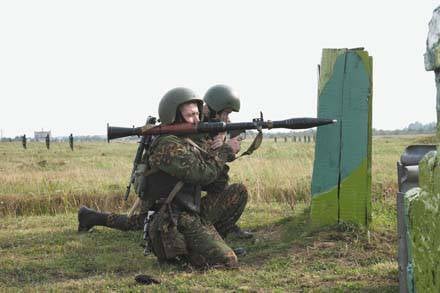 Intensive saturation of armored vehicles of armies of almost all countries of the world in the second half of the twentieth century and its active use in all types of combined arms combat created the conditions under which it became necessary to equip infantry with adequate means to combat enemy armored vehicles. The crisis of classic anti-tank melee infantry weapons (artillery shells; anti-tank guns; anti-tank grenades) led the gunsmith designers to a fundamentally new solution to this most serious problem - the creation of anti-tank complexes weapons: hand-held anti-tank grenade launchers adapted for firing from the shoulder, and cumulative grenades, thereby initiating a new direction in the development of weapons business. Numerous local wars and military conflicts 1970 – 1990-ies. confirmed once again that anti-tank grenade launchers are one of the most effective means in the fight against enemy armored vehicles.
Intensive saturation of armored vehicles of armies of almost all countries of the world in the second half of the twentieth century and its active use in all types of combined arms combat created the conditions under which it became necessary to equip infantry with adequate means to combat enemy armored vehicles. The crisis of classic anti-tank melee infantry weapons (artillery shells; anti-tank guns; anti-tank grenades) led the gunsmith designers to a fundamentally new solution to this most serious problem - the creation of anti-tank complexes weapons: hand-held anti-tank grenade launchers adapted for firing from the shoulder, and cumulative grenades, thereby initiating a new direction in the development of weapons business. Numerous local wars and military conflicts 1970 – 1990-ies. confirmed once again that anti-tank grenade launchers are one of the most effective means in the fight against enemy armored vehicles.Anti-tank grenade launchers have become one of the most powerful infantry weapons to combat tanks in close combat. This extremely effective and at the same time light and maneuverable and at the same time simple and cheap weapon allowed infantrymen in the conditions of modern maneuverable combat to fight on equal terms with almost all enemy tanks. They have high armor penetration, which allows the grenade launcher to successfully hit modern tanks of any type, destroy armored self-propelled guns and other mobile weapons. In addition, fragmentation grenades to combat enemy manpower significantly increased the effectiveness of these weapons. Shooting from hand grenade launchers is carried out with fired grenades with a super-caliber or caliber head part of a cumulative or fragmentation effect.
The anti-tank grenade launcher of our day is a multifunctional grenade launcher complex, which includes a smooth-bore recoilless system and active-reactive shots. A grenade is fired from a grenade launcher using a starting powder charge. At the initial part of the trajectory, the jet engine turns on, which increases the speed of the grenade. The recoilless grenade during firing is ensured by the fact that some of the powder gases are discharged back through the nozzle and the socket of the nozzle. This forms a reactive force directed forward. She balances the power of return.
Currently, the Russian army is armed with numerous anti-tank melee weapons, including the RPG-7 anti-tank grenade launcher complex consisting of a starting device (grenade launcher); shot (grenade) and sighting device. This weapon, which was put into service in the 1961 year, is still unparalleled in combat and performance characteristics.
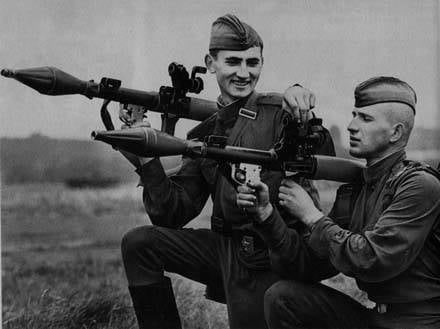 The development of anti-tank melee weapons began in the Russian design bureaus and scientific research institutes immediately after the end of World War II. One of the first Soviet models of such weapons was the RPG-1 and RPG-2 hand-held anti-tank grenade launchers, created in the OKB-2 of the Kovrov Arms Plant under the supervision of the lead designer NPRassol at the end of the 1940s.
The development of anti-tank melee weapons began in the Russian design bureaus and scientific research institutes immediately after the end of World War II. One of the first Soviet models of such weapons was the RPG-1 and RPG-2 hand-held anti-tank grenade launchers, created in the OKB-2 of the Kovrov Arms Plant under the supervision of the lead designer NPRassol at the end of the 1940s. In 1954, in the USSR, the development of a more advanced hand-held anti-tank grenade launcher with a propelling charge of smokeless (or low smoke) gunpowder having an increased direct shot range and greater armor penetration begins. Based on the research and experimental work carried out, the head research institutes are GSKB-30; SRI-1; SRI-6; NII; SNIP together with OKB-2 determined the design of samples of a dynamo-assisted grenade launcher and an anti-tank grenade with a charge to it for subsequent experimental development.
In this case, three design schemes with the use of the trunk were recommended: the first with an additional chamber; the second with a barrel having a local expansion, and the third with a barrel of equal section, having a nozzle inside, and a bore in the breech.
When working on the creation of grenade launchers, the head organization was the grenade developer, GSKB-47 (at present, FSUE “GNPP“ Bazalt ”). He, together with the developer of the propellant charge, determined the main dimensions and profile of the barrel of a grenade launcher, and OKB-2 (later OKB-575), based on the data, designed and worked out the starting device.
Hand-held anti-tank grenade launcher RPG-7 worked out in Kovrovsky OKB-575 with 1958 year. Factory tests of the RPG-7 were carried out at the test site from February 25 to February 11 and 1960 showed that rocket launchers meet the requirements of the specification. Already in 1961, the Kovrovsky Mechanical Plant mastered the production of an RPG-7 grenade launcher.
Production of 40-mm anti-tank grenade launchers RPG-7 continues to this day, not only in Kovrov, but also under license in many countries of the world: in China, Egypt, etc.
RPG-7 has become one of the most common anti-tank grenade launchers. Currently, he is in service with armies of more than 50 states. This grenade launcher and its numerous modifications were successfully used in almost all wars and military conflicts of the second half of the twentieth century.
The RPG-7 grenade launcher was a significant step forward, its direct shot and target range increased. In addition, the shooting of RPG-7 and its modifications could be conducted not only on tanks, self-propelled artillery installations and other enemy armored vehicles, but also to destroy enemy firepower and manpower, as in light field-type shelters, in buildings urban type or in open areas; for the destruction or damage of the bunker, the bunker, the building (volume up to 80 sq. m). Firing on hovering helicopters is allowed.
The RPG-7 grenade launcher consists of a barrel with mechanical sighting devices, a firing mechanism with a safety device, a striker mechanism, an optical sight PGO-7.
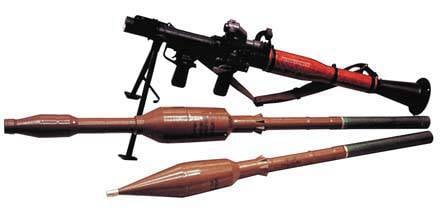 The barrel of the grenade launcher, designed to direct the flight of a grenade and remove powder gases when fired, is a smooth pipe, in the middle of which there is an expansion chamber. The nozzle has a bell, and in the middle part - a nozzle, made in the form of two converging cones. In the RPG-7, the barrel and the nozzle are threaded. The nozzle in the front part has a nozzle, in the back - a socket with a safety plate protecting the breech breech from contamination when accidentally plugging into the ground, etc. The barrel has a cutout in front for the grenade lock, on top - a folding front sight and a sight on special bases, the trigger and trigger mechanism mounted in the pistol grip of the fire control, which makes it easier to hold the grenade launcher, is mounted on the bottom. The barrel on the left has a strap for mounting an optical sight bracket. On the right, antabas are mounted for fastening a belt with covers and a shoulder belt. Two symmetrical birch veneer plates on the grenade launcher are fixed on the barrel of the grenade, protecting the hands of the grenade thrower from burns when firing.
The barrel of the grenade launcher, designed to direct the flight of a grenade and remove powder gases when fired, is a smooth pipe, in the middle of which there is an expansion chamber. The nozzle has a bell, and in the middle part - a nozzle, made in the form of two converging cones. In the RPG-7, the barrel and the nozzle are threaded. The nozzle in the front part has a nozzle, in the back - a socket with a safety plate protecting the breech breech from contamination when accidentally plugging into the ground, etc. The barrel has a cutout in front for the grenade lock, on top - a folding front sight and a sight on special bases, the trigger and trigger mechanism mounted in the pistol grip of the fire control, which makes it easier to hold the grenade launcher, is mounted on the bottom. The barrel on the left has a strap for mounting an optical sight bracket. On the right, antabas are mounted for fastening a belt with covers and a shoulder belt. Two symmetrical birch veneer plates on the grenade launcher are fixed on the barrel of the grenade, protecting the hands of the grenade thrower from burns when firing.The trigger mechanism has an open trigger, a helical combat spring, trigger, push-button fuse. To put the grenade launcher on the fuse, the button must be pressed to the right. The cock is cocked for the knitting needle with the thumb.
In connection with the increase of the targeting range to 500 meters for the RPG-7 grenade launcher in the Novosibirsk Tochpribor TsKB, an 2,7-multiple prismatic-type OGO-7 optical sight with a field of view 13 degrees, which became the main sight for this type of weapon, was developed. His aiming reticle includes a sight scale (horizontal lines), a side correction scale (vertical lines), and a rangefinder scale (solid horizontal and dashed curve lines) to determine the distance to the target with a height of 2,7 meter.
The price of dividing the scale of the sight is 100 meters, the scales of the side corrections are 0 – 10 (10 thousandths). The limits of the scale of the sight - from 200 to 500 meters. The divisions (lines) of the sight scale are indicated by the numbers "2", "3", "4", "5" corresponding to the firing range in hundreds of meters (200, 300, 400, 500 m). The divisions (lines) of the lateral correction scale are indicated below (left and right of the center line) by the numbers 1, 2, 3, 4, 5. The distance between the vertical lines corresponds to ten thousandths (0 – 10). The scale line corresponding to the 300 range of m, and the center line of the scale of the side corrections are made double to facilitate the selection of the necessary divisions when aiming. In addition, the center line is continued below the scope of the sight to detect the side tilt of the grenade launcher.
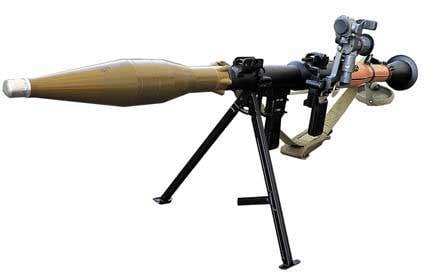 The distance scale is designed for the target height of the 2,7 meter (approximate height of the tank). This target height is indicated below the horizontal line. Over the upper dotted line there is a scale with graduations that correspond to the change in the distance to the target on 100 m. The numbers on the 2, 4, 6, 8, 10 scales correspond to the 200, 400, 600, 800, 1000 distances m. Above the target scale, is indicated by a , Serving to check the sight.
The distance scale is designed for the target height of the 2,7 meter (approximate height of the tank). This target height is indicated below the horizontal line. Over the upper dotted line there is a scale with graduations that correspond to the change in the distance to the target on 100 m. The numbers on the 2, 4, 6, 8, 10 scales correspond to the 200, 400, 600, 800, 1000 distances m. Above the target scale, is indicated by a , Serving to check the sight.The sight is equipped with adjustment screws for height and direction, a handwheel for entering the temperature correction, a grid illumination device, a rubber nalobnik and an eyecup. Optical sight PGO-7 is the main sight of a grenade launcher.
The mechanical sight (with a folding front sight and entirely) is used as an auxiliary in case of damage (failure) of the main optical sight. Its bar has a movable collar with a slit and a latch, the bar “2”, “З”, “4”, and “5” divide the same as the 200, 300, 400 and 500 m ranges. On the RPG-7 B, apart from the main one, the folding additional fly was mounted : the main one was used at minus, and the additional one at positive air temperature.
The active-reactive 85-mm PG-7 B shot consisted of a PG-7 grenade (weight - 2,2 kg) and a powder (propelling) charge. The PG-7 anti-tank grenade included a cumulative charge head, a fairing and a conductive cone (the head and bottom parts were connected into a single chain through a fairing and a cone), a powder jet engine with six nozzles, a stabilizer with four folding feathers and a turbine . For the message to the grenade of the initial velocity (120 m / s), a starting powder charge was attached to the jet engine during loading, placed in a paper case to protect it from moisture and mechanical damage during storage and transportation. A jet engine of length 250 mm, which served to increase the speed of a grenade from 120 m / s to 330 m / s, was attached to the back of the grenade head. The jet engine was activated only after the grenade was at a distance of 15 – 20 meters from the shooter. The nozzles of the power unit were located at an angle to the body to create rotational motion of the grenade in flight. The stabilizer provided a steady flight of a grenade on the trajectory. On the stabilizer tube was a retainer, which, when loaded, entered the cut-out on the muzzle of the rocket launcher.
The flexible plumage of the grenade was bent around the stabilizer tube and secured in such a position by a ring. The impeller was located tracer for monitoring the flight of a grenade. The exploder served to break a grenade when meeting it with a target (barrier). It has a head and bottom parts connected by an electrical circuit. The fuse's runtime was 0,00001 seconds. The armor penetration capability of the PG-7 B grenade was 260 mm.
The kit of the grenade launcher included spare parts, shoulder strap, two bags for grenades and powder charges. Wearable ammunition was 5 shots.
The PUS-7 device, which externally simulates a PG-7 B shot, but has a barrel equipped with an 7,62-mm automatic cartridge of the 1943 model with a tracer bullet, is used to train the grenade throwers.
To load a grenade launcher it was necessary first to put it on safety and then insert the prepared grenade into the muzzle of the barrel. At the same time, the grenade stabilizer retainer entered the notch on the barrel. In this position, the primer-igniter is located against the opening for the striker.
To make a shot, it was necessary to: put the trigger on a combat platoon; remove the grenade launcher from the safety catch and use the index finger to pull the trigger. Under the action of the mainspring trigger energetically turned up and hit the striker. The striker moved upwards, breaking the primer-igniter of the grenade, the powder charge ignited. The pressure of the powder grenade gases was ejected from the barrel. After the grenade was taken out of the grenade launcher, the stabilizer's feathers were opened under the action of the incoming air flow (and centrifugal forces, as the grenade was rotated), which ensured the stability of the grenade in flight. When fired, the tracer also ignited and the combustion of the retarding composition began, from which the powder charge of the jet engine ignited. Due to the outflow of powder gases through the nozzle holes, a reactive force was formed, and the speed of the grenade increased. In the future, the grenade flew by inertia. The engine was turned on at a safe distance from the rocket launcher.
At a distance of 2,5 – 18 m from the muzzle of the barrel, the fuse was cocked - the electric detonator was connected to an electrical circuit. The slow rotation of the grenade around its longitudinal axis in flight partially compensated for the deviation of the engine thrust, increasing the accuracy of fire. When a grenade met an obstacle (target), the fuse piezoelectric element was compressed, as a result of which an electrical current was generated, under the action of which the fuse electric detonator exploded. A detonator exploded and a grenade explosive exploded. When the grenade exploded, a cumulative jet was formed, which pierced the armor (barrier), hit manpower, destroyed weapons and equipment, and also ignited the fuel. As a result of the concentration of the explosion energy and the creation of a compacted gas-metal jet in the cumulative cavity, the particles of the outer metal layer of the crater under the action of an elastic impact received movement, breaking away from the funnel, and flew at high speed (up to 12000 – 15000 km / s), forming a needle cumulative jet. The cumulative energy of the jet passed into a pressure energy equal to P = 1000000 – 2000000 kg / cm2, as a result of which the armor metal had expired without being heated to the melting point (the temperature of the cumulative jet was 200 – 600 ° C).
If the grenade did not hit the target or the electric part of the fuse failed, then through 4 – 6 seconds after the shot, the self-detonator worked and the grenade exploded. When fired, the RPG-7 grenade launcher had no recoil. This was provided by the expiration of the powder gases back through the nozzle and the socket of the nozzle pipe. The resulting forward reactive force balances the recoil force.
The RPG-7 hand-held anti-tank grenade launcher in combat was served by two crew numbers - a grenade launcher and an assistant grenade launcher. From the beginning of the 1960-s, the RPG-7 grenade launcher with the PG-7 B shotgun became the main anti-tank melee weapon of the motorized rifle squad of the Soviet Army.
With the improvement of armored vehicles, with the expansion of the range of tasks facing the motorized rifle units, domestic gunsmiths designers had to constantly upgrade and improve grenade launchers.
In the middle of the 1960-ies, the family of domestic anti-tank grenade launchers expanded with the adoption of another assault variant RPG-7 D (TKB-02). Created in 1960 – 1964 by VF Fundaev, designer of the Tula Central Design Bureau of Hunting and Sports Weapons (TsKIBSOO), this grenade launcher was intended to be used by the Airborne Forces. He had a collapsible barrel. Before landing paratroopers in airplanes, RPG-7 D grenade launchers were disassembled into two parts (with a total length of 630 mm in the dropping position) and packed into a single bag, and quickly assembled on the ground for 50 – 60 seconds. For this, the barrel and the branch pipe of the RPG-7 D were connected with a quick-disconnecting rusk joint, and there was a obturator at the point of joint to prevent the breakthrough of powder gases. The locking mechanism prevented the shot with the pipe unturned. For shooting RPG-7 D grenade launchers were completed with a quick bipod.
And soon two more modifications of the RPG-7 N and RPG-7 DN grenade launchers with the PGN-1 night-time optical sight appeared. They were also equipped with a quick bipod.
Simultaneously with the improvement of the combat qualities of the RPG-7 hand-held anti-tank grenade launchers, there was an improvement in the shots to them. So, already in 1969, an 70-mm upgraded shot of PG-7 BM with a weight of 2,0 kg appeared. Compared to the PG-7 B shot, the new shot was not only lighter, but also surpassed it in armor penetration, close combat and wind resistance. So, its armor penetration is now 300 mm of homogeneous steel armor. The PG-7 VM shot was produced up to the 1976 year. The adoption of this shot led to the creation of an improved optical sight PGO-7 B.
In connection with the appearance of potential tanks among our potential opponents (in the USA - Abrams М1; in Germany - Leopard-2; in the UK - Chieftain MK.2) with multi-layer composite armor, which negated the long-term efforts of the Soviet designers, our gunsmiths urgently had to find new ways to solve this problem. The capabilities of the RPG-7 grenade launcher have increased significantly with the advent of new, more effective shots.
At the beginning of the 1970-s, RPG-7 grenade launchers received more powerful 72-mm guns PG-7 BC and PG-7 BC1, the armor penetration rate of which increased to 360 – 400 mm. In 1977, the Soviet Army received another 93-mm grenade launcher PG-7 VL (informally named “Beam”) with increased armor penetration to 500 mm, which greatly expanded the combat capabilities of RPG-7 grenade launchers. The mass of the shot was now - 2,6 kg. In addition, this more powerful grenade could also pierce a one and a half meter brick wall or a reinforced concrete slab with a thickness of 1,1 m.
The qualitative growth of the armor protection of the main battle tanks, the widespread introduction of elements of mounted or built-in dynamic protection in their designs in the 1980-ies demanded the creation of new anti-tank shots. In order to effectively combat the enemy's new tanks in 1985, the designer A. B. Kulakovsky created the PG-7 BP (“Summary”) shot with a tandem warhead in the SNNP “Basalt”. Two cumulative charge PG-7 BP installed coaxially and spaced. The first 64-mm charge undermined the element of dynamic protection, and the second, the main 105-mm punched through the armor itself. To increase the armor penetration, the caliber of the warhead had to be increased to 105 mm, and the increased mass of the grenade reduced the range of aimed shooting to 200. Grenade PG-7 BP allows you to break through a 1.5-meter reinforced concrete block. For greater convenience of carrying in the traveling position of the PG-7 BP shot, the warhead is separated from the jet engine with a propelling charge.
The experience of recent local wars and military conflicts at the end of the 20th and the beginning of the 21st centuries clearly demonstrated the need to turn a hand-held anti-tank grenade launchers into a multi-purpose support for a motorized rifle (airborne) unit capable of fighting various types of targets. During the military operations of the Soviet troops in Afghanistan, even the cumulative PG-7 B and PG-7 VL grenades helped the grenade launchers in the fight against the enemy’s firing points more than once. To expand these capabilities, the same designer, AB Kulakovsky, developed a TBG-7 B thermobaric jet shot (“Tannin”) with a mass of 1,8 kg and an aimed range of 200 m. During firing, this grenade first fires and explodes The main charge of the thermobaric mixture. Volumetric explosion leads to significantly more severe damage than conventional artillery ammunition. This shot is designed to defeat the enemy's manpower in the trenches and light field shelters. The effectiveness of the explosive action TBG-7 B is comparable to 120-mm artillery shells or mortar shells. As a result, a hole with a diameter of 150 – 180 mm or a 200 break on 500 mm with a guaranteed defeat of living force by small fragments in a radius of up to 10 m is formed as a result of buildings. At the same time, a TBG-7 shot can hit unarmored or lightly armored vehicles as well as light ones. barriers.
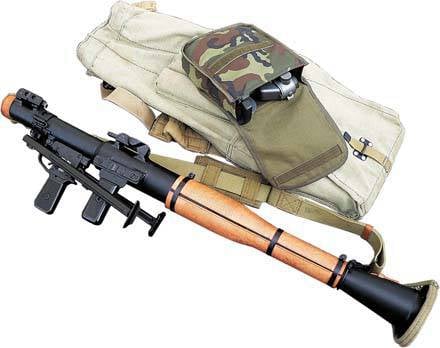 In 1998 – 1999, an OG-7 B shot with a caliber 40-mm fragmentation grenade without a jet engine, with aimed aiming up to 300 m was created to combat manpower (including equipped with personal protective equipment - body armor). The firing accuracy of this grenade declared by the manufacturer is sufficient to hit a separate firing point in the room, an embrasure firing facility, etc.
In 1998 – 1999, an OG-7 B shot with a caliber 40-mm fragmentation grenade without a jet engine, with aimed aiming up to 300 m was created to combat manpower (including equipped with personal protective equipment - body armor). The firing accuracy of this grenade declared by the manufacturer is sufficient to hit a separate firing point in the room, an embrasure firing facility, etc. Creation of new grenade launchers with increased mass and increased ballistic characteristics demanded modernization of the RPG-7 B grenade launcher itself. Therefore, in the early 1990-x, the upgraded RPG-7 В1 model was adopted by the Russian army (in the landing version of the RPG-7 D2) with a removable bipod and improved sights - the new PGO-7 B3 optical sight and an improved mechanical sight. Along with the PGO-7 B3 optical sight, the RPG-7 B1 grenade launcher also received a new universal aiming device UP7 B, which made it possible to increase the range of target shooting with TBG-7 B shots (to 550 m) and OG-7 V. From an upgraded grenade launcher, you can shoot all the previously created shots.
Information